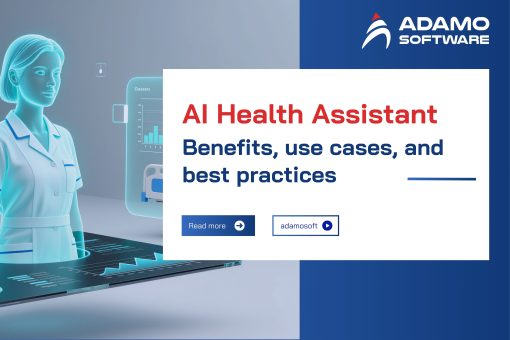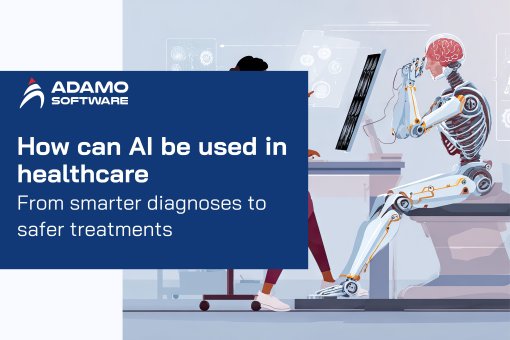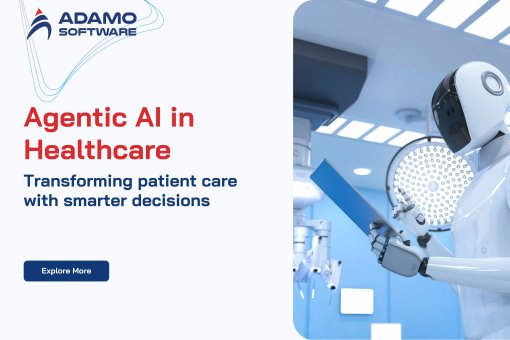How to Develop Custom Healthcare SaaS Application in 2026

Healthcare SaaS solutions play an important role in modern healthcare. Healthcare software as a service and provide market-ready options. These options enable healthcare providers to streamline operations, enhance patient care, and secure sensitive medical data. They exclude custom solutions. Healthcare software solutions lead the way in technological innovation. They leverage technologies, like artificial intelligence, machine learning, and predictive analytics to enhance their capabilities and drive better outcomes. These technologies drive operational efficiency and improve patient outcomes.
This blog will delve into a comprehensive overview of SaaS for healthcare. Afterward, you will clearly understand the best types of Healthcare SaaS available in 2024. Enables you to make informed decisions for your healthcare organization’s success.
I. Healthcare SaaS Market Overview: Statistics and Trends
1. Healthcare SaaS Market Statistics
The global healthcare software market size was valued at US$ 12.5 billion in 2020. It is expected to expand at a compound annual growth rate (CAGR) of 19.5% from 2021 to 2028. The increasing adoption of cloud technology and digitalization in healthcare is driving the growth of the healthcare SaaS market during the forecast period. According to a report by Right Scale, as many as 94% of enterprises were using the cloud in 2019. The report also suggests that shortly, around 21% of enterprises are planning to install cloud.
Healthcare companies are adopting SaaS healthcare for its great benefits, such as cost benefits, security, ease of use, and customer support. It also offers advanced management and administration, scalability, uptime guarantee, customization, data center infrastructure, disaster recovery planning, and reporting.
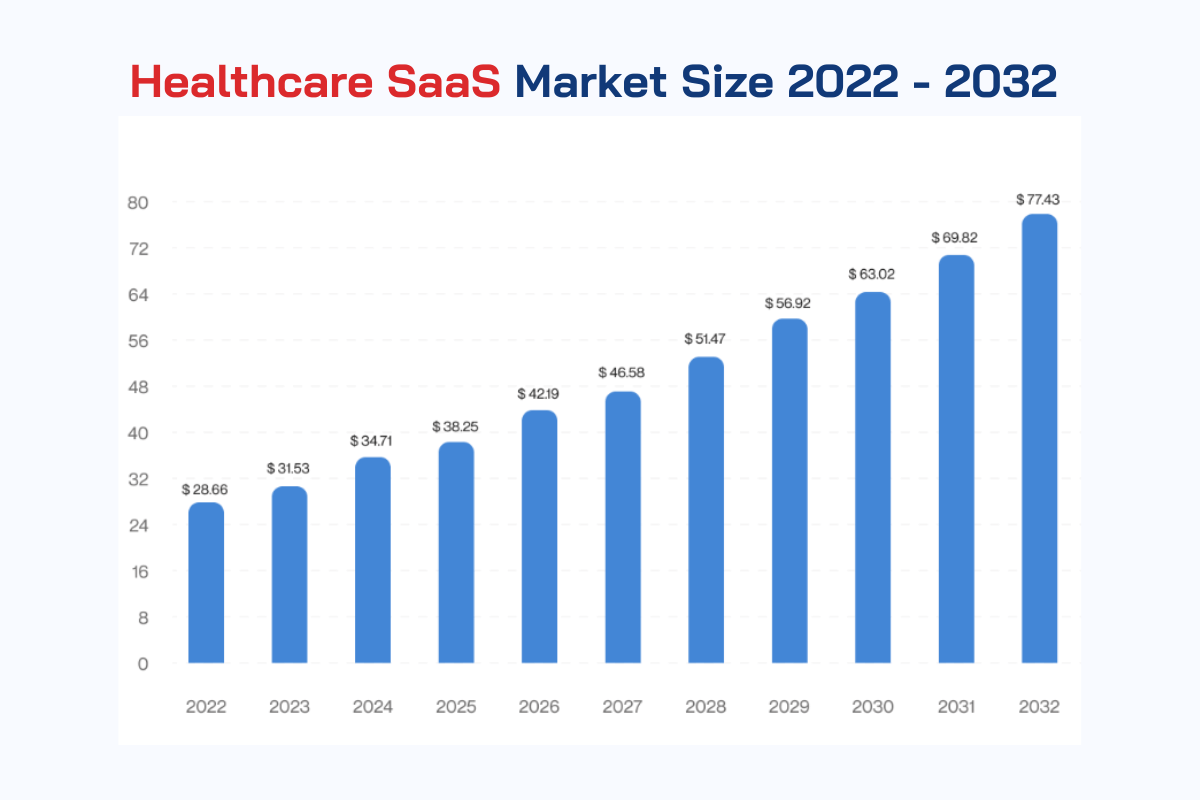
SaaS in healthcare can be found in various applications such as websites, email, and communications. It also includes mobile services, CRM, mobility services, productivity applications, ERP, data analytics, document management, and database servers. After the COVID-19 pandemic, digitalization has accelerated and grown rapidly in the healthcare sector. Healthcare organizations face many challenges such as resource shortages and labor shortages.
Therefore, these organizations have started adopting digital platforms to overcome the challenges and increase the return on investment during the pandemic. In 2021, a survey by Innovaccer Inc. found that 49% of healthcare organizations are moving toward digital transformation.
Healthcare organizations aim to provide remote healthcare services to 39% of people. Automate care management for 30% of people. Automate care pathways and coordination to 20% of people, and enhance triage and risk assessment to 11%. Moreover, improving clinical operations, modernizing data platforms, integrating disparate systems, and streamlining IT spending are among the top priorities for these organizations. Therefore, increasing plans to install and upgrade advanced digital facilities are forecasted to drive market growth.
The rise of telehealth, wearables, apps, remote monitoring, ERP, CRM, and patient data is driving this growth. A report from the International Telecommunication Union predicts that 12.1 billion people will own smartphones by 2030. A study published in the Journal of Medical Internet Research in 2020 discovered that 30% of adults in the U.S. regularly use wearable devices. Additionally, a 2017 study by the European Commission revealed that 96% of European physicians use EHRs. These factors all contribute to the rising adoption of SaaS.
Telemedicine is increasingly being adopted, with more focus on cloud computing and SaaS during the COVID-19 pandemic. This is also expected to contribute to the growth of the market in the coming years. According to a study by Flexera, cost savings and moving workloads to the cloud are some of the major cloud initiatives. In 2019, 64% of people said that they were interested in saving costs. This number increased to 73% in 2020. Furthermore, in 2019, around 58% of people were interested in moving workloads to the cloud, which increased to 61% in 2020.
SaaS healthcare companies are adopting strategies like new product development and mergers and acquisitions. Partnerships, collaborations, and joint ventures are expected to drive market growth in the coming years. For example, in August 2021, Telstra Health announced plans to acquire MedicalDirector for $256 million. MedicalDirector offers healthcare SaaS for practice management, electronic health records, and billing. They also provide care coordination, scheduling, clinical content, medication information, and cybersecurity solutions.
Healthcare’s demand for advanced software boosts the rapid growth of healthcare SaaS, offering more flexibility and accessibility. Healthcare SaaS is dominating the cloud computing world today and will continue to expand in the future.
2. Healthcare SaaS trends
With the latest trends in healthcare SaaS, healthcare professionals can expect the following growth trends to expand further by 2024:
– Artificial Intelligence: AI (artificial intelligence) and NLP (natural language processing) are prevalent in cloud solutions. These platforms may grow in the healthcare SaaS world, as the healthcare cloud computing market is expected to grow.
– API Connectivity: The ability to integrate with existing systems is a must in the healthcare industry. Hence, as healthcare SaaS solutions become more popular, API connectivity will grow strongly.
– Mobile Optimization: 80.69% of the world’s population owns smartphones. Of these, 23% of mobile phone users install health-related applications on their devices. To serve the needs of users, healthcare SaaS products need to have even more excellent functions.
– Telemedicine: Analysts estimate that the global telemedicine market will be worth $171.81 billion by 2026. With the ability to provide convenient and accessible patient care, telemedicine has seen significant growth. In particular, healthcare SaaS solutions such as EHR software combined with telemedicine are an important application of SaaS in healthcare.
– Vertical SaaS: Due to its ability to meet customer needs, vertical healthcare SaaS is expected to grow.
– PaaS model: One of the major focuses of healthcare providers remains customer retention. This model facilitates due to the ability to create custom applications, making them increasingly popular.
– DaaS Integration: Today, healthcare and medical organizations are increasingly relying on AI to ease the burden on healthcare professionals. Therefore, the rise in healthcare data will see the rise of Data as a Service in the healthcare industry.
– Use of multiple cloud services: Multiple cloud services ensure interoperability with APIs. This builds strong data interoperability in healthcare. Using a multi-cloud environment is cost-effective and does not require additional costs for security and scalability.
– Edge computing: The increase in healthcare data is expected to drive the growth of edge computing in healthcare SaaS. This edge computing acts as a complement to the cloud and supports data storage, processing, and analytics.
You can explore more about Hospital Management Systems: Types, Key Features & Must-Know Insights here.
II. Why You Should Have Custom SaaS for Healthcare
Today, managing technology infrastructure is extremely complex and difficult, especially for inexperienced people. With healthcare professionals by incorporating healthcare SaaS (integrating all applications in one environment). It will be easier to manage critical data and focus more on the patient’s medical health. The important reasons mentioned below clearly state why you must consider Healthcare SaaS applications as a provider.
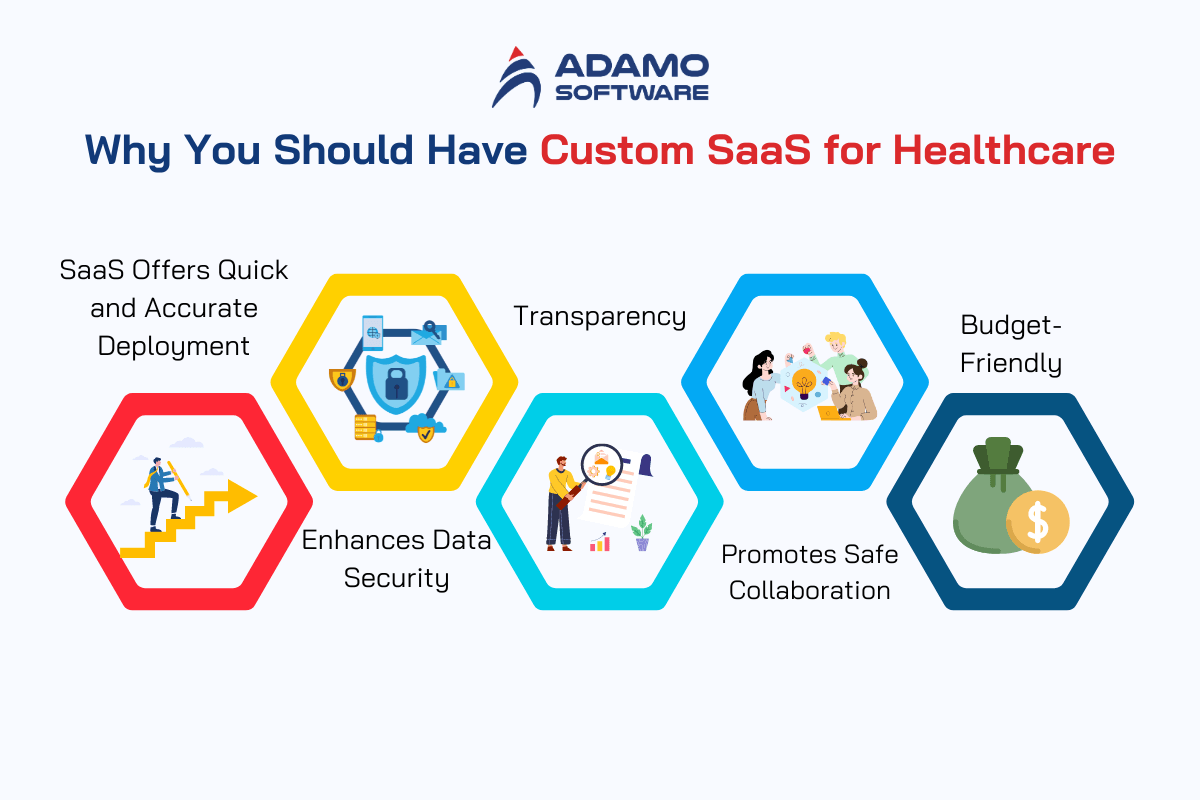
1. SaaS Offers Quick and Accurate Deployment
Because things are happening so fast, medical professionals need to keep up with the pace and come up with the right solutions quickly. Healthcare SaaS-based solutions such as electronic health records or Electronic Medical Records (EMR in software products) can ensure speed and accuracy while diagnosing patients. One of the common misconceptions in the healthcare SaaS space is that developing SaaS models is a one-time process. However, this does not make some service providers inclined to offer 24/7 services. They understand the need to ask medical professionals to avail of this service to a large extent.
2. Enhances Data Security
One of the most important aspects of the healthcare SaaS industry is patient data. And because it is so valuable, data is always under threat. SaaS for healthcare solutions provides superior data security.
With the ever-increasing scope of data, healthcare providers are under constant pressure to keep important patient information secure. Lack of cybersecurity and failure to maintain cybersecurity and firewalls have become one of the major weaknesses. Vertical SaaS solutions are quite profitable right now. Because these products incorporate advanced security and privacy features, bad actors cannot steal such information. So, data security and privacy are officially another advantage that healthcare SaaS applications offer.
3. Transparency
Previously, it was difficult for doctors and other medical professionals to review a patient’s medical history. Fortunately, this technology allows doctors can observe medical history easily and understand patient details, as everything is recorded and available. This also allows them to treat their patients with more accurate diagnoses. Electronic health records have brought remarkable transparency between both doctors and their patients.
4. Promotes Safe Collaboration
Like any other business, even these areas require effective internal collaboration. Here, the Hospital Management Software (HMS) system works wonders. These systems track operations and enable professionals from various departments to collaborate effectively across the healthcare industry. When everything works in sync, it can help improve revenue management.
5. Budget-Friendly
Last but not least is cost savings. Gone are the days when healthcare providers had to pay capital upfront. This is no longer necessary. These commercial business solutions are affordable in terms of price. All unnecessary management and maintenance costs can be bypassed by combining these systems and solutions.
III. Common Types of Healthcare SaaS
With growing awareness of health issues, healthcare SaaS agencies are developing more technologies to meet global user needs. The demand for security, patient data management, and top-notch services has increased software adoption in the healthcare SaaS industry.
Follow the examples below of healthcare SaaS software:
1. Electronic Health Record (EHR) Software
EHR software is essential for SaaS healthcare companies because it supports patient medical record management, including diagnosis, treatment, and prescriptions. Choosing the right EHR software development company will significantly improve the efficiency and outcomes of patient data in your healthcare SaaS solution. The best examples to look at for EHR software include Epic, Cerner, and Allscripts.
2. Telemedicine software
Online medical software enables remote consultation and diagnosis, improving patient access to SaaS in healthcare. Some of the most popular examples of online medical software include Teladoc, Doctor on Demand, and Amwell.
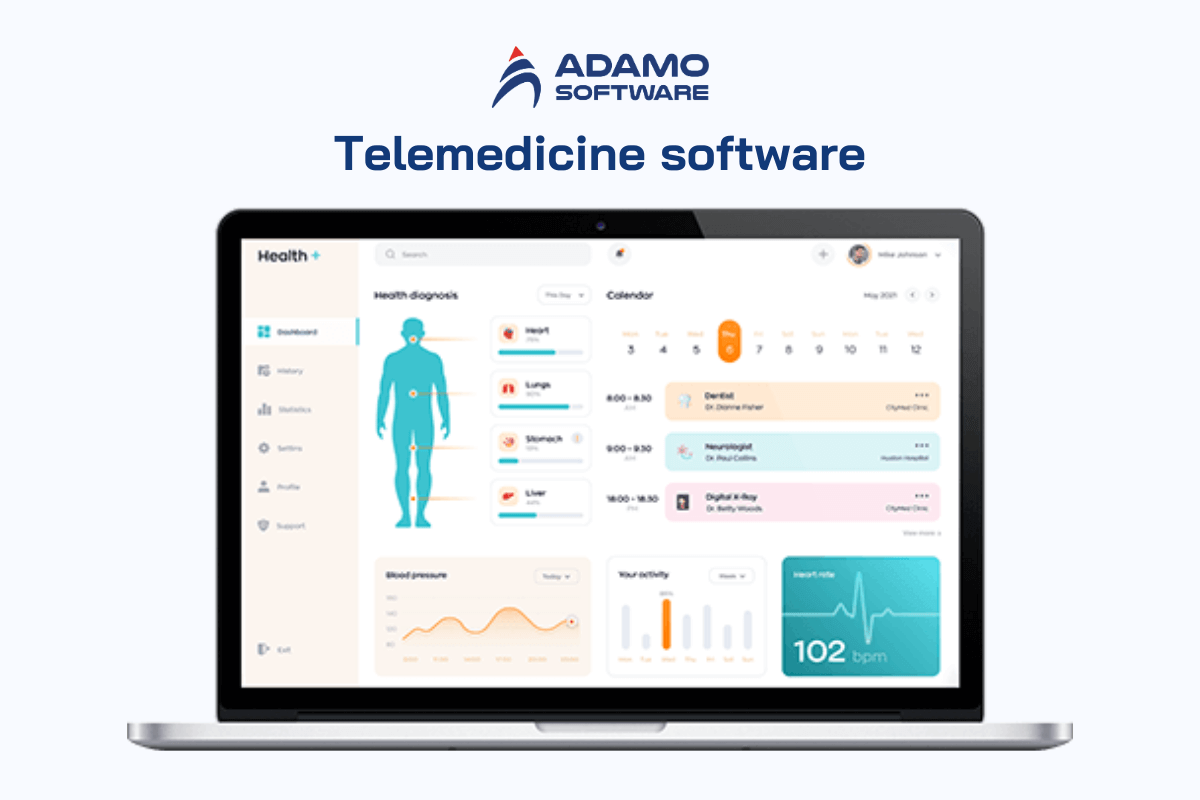
3. Medical clinic management software
This software helps SaaS healthcare providers manage their clinics, including patient scheduling, billing, and insurance claims processing. The best examples of medical practice management software include AdvancedMD, Kareo, and Athenahealth.
4. Clinical decision support software
This type of solution empowers SaaS healthcare providers to support real-time decision-making based on the latest medical information and best practices. Typical candidates for clinical decision support software include IBM Watson, Cerner Clinical Decision Support, and UpToDate.
5. Healthcare analytics software
This software assists healthcare SaaS organizations in analyzing patient data and improving patient outcomes. Examples of healthcare SaaS analytics software include IBM Watson Health, Cerner Millennium, and MedeAnalytics.
6. Patient portal software
Patient portal software provides patients with secure access to their medical records, thereby helping them stay informed about their health information. The most prominent examples of patient portal software include MyChart, HealtheLife, and FollowMyHealth.
7. Radiology Information System (RIS) Software
The Department of Radiology uses RIS software to manage data and results images. It is essential software for SaaS healthcare SaaS companies, and the best examples of RIS software include Cerner RadNet, MedWeb, and Agfa HealthCare.
8. Laboratory information system (LIS) software
The testing department uses LIS software to manage test results and patient test data. References for LIS software includes Cerner PathNet, Sunquest and McKesson LIS.
IV. Complete Guide to Build a Healthcare SaaS Application
Building a healthcare SaaS application is difficult. It requires a lot of collaboration, preparation, and resources. Here are five detailed steps to building a healthcare SaaS application:
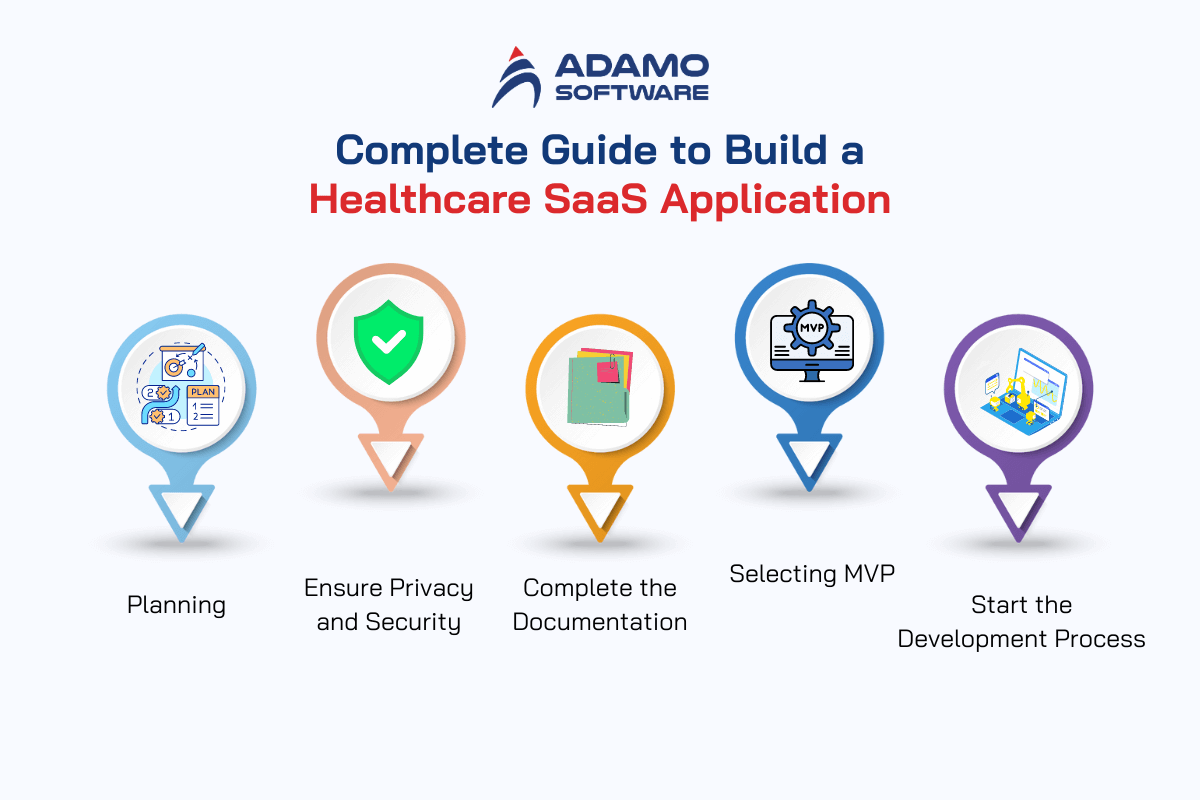
Step 1. Planning
The first step to building a healthcare SaaS is planning. You need to identify your needs and goals and come up with a comprehensive plan. You can decide who will be the end users and what functionality you want to add to the application to make it easy for the end users to use. Therefore, to accurately map out all your needs, you can hire a healthcare technology consulting firm.
In addition, you need to identify the target audience to finalize the technical specifications and architectural features of the SaaS application more specifically.
Step 2. Ensure Privacy and Security
The next important step is to ensure privacy and security. After carefully reviewing the technical specifications, the development company will identify performance and quality factors. They will list the factors that affect the healthcare SaaS application’s performance and quality. Suppose this list can provide a stable service environment and support multiple users with authorized access. It also offers cloud-based resource sharing and error security.
Step 3. Complete the Documentation
Step 3 is to finalize the documentation. Before moving on to any process, you must document all the technical specifications. This documentation may include project scope, user specifications, contracts, HIPAA and BAA, etc.
The documentation phase is considered very important because it is the step that completes your healthcare SaaS. It is also important to provide clear and concise documentation to ensure your MVP is of high quality.
Disorganized documents or vague specifications can harm the delivery of MVP. It is important to provide clear and concise documentation to ensure the quality of your MVP.
Step 4. Selecting MVP
MVP is an acronym for Minimum Viable Product. The MVP contains all the necessary features to function at a basic level. It’s simply a suggestion to determine if it’s the right solution for the issue you’re addressing. If the MVP isn’t a success, it won’t be moved on to the next development stage.
Development companies mostly use a variety of methods. At this stage, they experimented with various approaches to ensure they delivered a high-quality, solution-focused MVP to their client.
Following the MVP stage, the process moves into the development phase. Here, the development team will decide on the best technology stack and programming language for the client SaaS app.
Step 5. Start the Development Process
After completing the planning, documenting, and finalizing the technology stack. You take the next step is the development phase.
Developing a healthcare SaaS application, especially one for healthcare, requires a lot of skills and experience as the application will receive and process a lot of extremely sensitive data. The best option is to hire reputable developers or stick with the healthcare technology consulting firm you have worked with so far for development support. Developers with experience in front-end and back-end development, database queries, JavaScript libraries, healthcare SaaS applications, etc. should be preferred.
To develop a high-quality SaaS application, hire a dedicated team, collaborate regularly with healthcare SaaS vendors, and track progress weekly.
Finally, you proceed to the deployment and maintenance phase.
V. How to Choose a Trusted SaaS Healthcare Development Company
It is difficult to judge whether a software development partner is suitable for your company. There are many factors to consider when choosing a reliable company, such as expertise, outsourcing costs, etc.
Let’s explore the steps below to choose a reliable healthcare SaaS software development company.
Step 1:
- Test and review their portfolio.
- Look for projects they have done that are similar to your app and check their usability.
- Check the ratings and reviews of their previously designed apps on the store.
Step 2:
- Look for experienced professionals
- For example, if you want to use React for front-end development, look for a company that specializes in React.
Step 3:
- Look for issues with communication and responsiveness to emergency meetings.
- Look for companies that have an agile development approach.
Step 4:
- Choose a partner that is similar in environment and size to your company.
- In addition, a company with too many clients may not be of much interest to you.
Step 5:
- Choose a company that regularly updates you on the progress of their work. This helps to troubleshoot issues and improve your project development process. Avoid any sloppiness in quality.
Step 6:
- Consider the geographical location and time zone to ensure the application development process.
- Countries like Vietnam, Poland, India, China, Mexico, etc. are most recommended.
Step 7:
- Use a valuation method to select a software development company.
- Do not choose a fixed-price model.
Step 8:
- Prefer a company that provides complete paperwork, especially Intellectual Property.
- Suppose your partner company does not transfer the ownership of the project to you, you cannot monetize the project or develop on it.
VI. Adamo – A Reliable Partner for Healthcare SaaS Development
As healthcare businesses increasingly adopt cloud-based software to streamline operations, the demand for effective SaaS solutions grows. Some have deployed SaaS platforms, benefiting from reduced costs, security, and scalability. However, challenges arise when rolling out for end-users.

Adamo Software specializes in developing robust, secure, and scalable healthcare SaaS applications. Our expertise spans telehealth, remote patient monitoring, and on-demand healthcare solutions, ensuring comprehensive care and efficient patient data management. By leveraging advanced technologies like AI, machine learning, and IoT, we deliver innovative solutions tailored to the healthcare sector.
Suppose you wish to create a Healthcare SaaS application. Don’t hesitate to contact us for a consultation.







